
For many cruisers, reading is a major pastime, and the time to read is one of the great gifts of cruising. When Don and I did our big refit in Trinidad in ’99 we added 480 inches of teak shelving, tucked in from stem to stern. It’s the one thing boat designers totally forget about cruising, the amount of books we want to have on board.
Even with all the added shelving, I had to learn I couldn’t keep every book I read. Instead, beginning in ’01, Don and I each kept an Excel spreadsheet booklist. Since then a quick check reveals I have read 414 books and Don has read 283. (Our reading rate slows notably during time we spend back in the US!)
Those totals do not include reference books, manuals, cruising guides or Lonely Planets, and do include more mysteries, romances, and just plain junk than I would like to admit. But that’s the nature of cruisers’ reading; you read what you can swap for, and, for most entries, it was not any big deal to stamp them with our rubber “From the Library of Tackless II” stamp, scribble in the date and port, and leave them on a marina swap shelf.
But there are always books that, for one reason or another, have a major impact on you, books that you strive to keep no matter what. As a writer and a reader I have always thought of those books as experiences in themselves, and with the time cruising gave me to read, I found myself choosing more mentally-challenging reading. Our new bookshelves quickly became packed tight with books that were interwoven with my experience of our voyage.
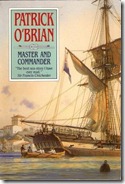 Early on, Don and I both were mostly addicted to nautical fiction, mostly the popular series by Patrick O’Brien (Jack Aubrey / Steven Maturin Novels), C. S Forester (Horatio Hornblower) and Alexander Kent (Richard Bolitho), all fictional heroes of the British navy in the 1700s-1800s. Their adventures were entertaining, of course, as we ourselves swashed through the islands, but they also painted a backdrop of seafaring’s historical role throughout the places we were visiting.
Early on, Don and I both were mostly addicted to nautical fiction, mostly the popular series by Patrick O’Brien (Jack Aubrey / Steven Maturin Novels), C. S Forester (Horatio Hornblower) and Alexander Kent (Richard Bolitho), all fictional heroes of the British navy in the 1700s-1800s. Their adventures were entertaining, of course, as we ourselves swashed through the islands, but they also painted a backdrop of seafaring’s historical role throughout the places we were visiting.
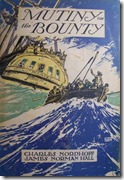 We also worked our way through other sea-going classics like:
We also worked our way through other sea-going classics like:
- Mutiny on the Bounty,
- The Voyage of the Beagle,
- and Two Years Before the Mast,
- even Homer’s Odyssey
- plus some more recent works like Eric Newby’s The Last Grain Race,
- Nathaniel Philbrick’s In the Heart of the Sea: The Tragedy of the Whaleship Essex;
- or Farley Mowatt’s The Boat Who Wouldn’t Float.
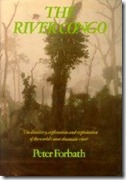 If I could pinpoint one book that changed the course of my subsequent reading it would be (perhaps oddly!) The River Congo, by Peter Forbath. At the time, we were traveling through Panama’s San Blas Islands with Bob and Kathy of the Tayana 37 Briana. Obviously we weren’t going anywhere near the Belgian Congo, but Bob had been born and raised there, and he lent us the book. This book brought uncomfortably alive the history of Belgium’s impact on the Congo, a history happening in the same period as so many great European seafaring explorations, and, in fact, a direct outgrowth of it.
If I could pinpoint one book that changed the course of my subsequent reading it would be (perhaps oddly!) The River Congo, by Peter Forbath. At the time, we were traveling through Panama’s San Blas Islands with Bob and Kathy of the Tayana 37 Briana. Obviously we weren’t going anywhere near the Belgian Congo, but Bob had been born and raised there, and he lent us the book. This book brought uncomfortably alive the history of Belgium’s impact on the Congo, a history happening in the same period as so many great European seafaring explorations, and, in fact, a direct outgrowth of it.
Until that book I’d had little interest in history except as a backdrop for a good novel. And though I’d thought myself a worldly person, I was forced to realize how little I actually understood of what historical forces had steered all the stuff going on in the world.
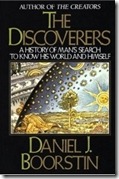 A perfect next step was Daniel Boorstein’s excellent and panoramic The Discoverers: A History of Man’s Search to Know his World and Himself. In a preamble, Boorstein says his hero is “Man the Discoverer” and in the book he examines all the horizons that mankind has had to aim at, not just physical ones, but conceptual ones, each of which “had to be opened for us by countless Columbuses” (including a huge section on Chinese exploration!) It made me keen to be my own Columbus, but also to be a careful and considering one.
A perfect next step was Daniel Boorstein’s excellent and panoramic The Discoverers: A History of Man’s Search to Know his World and Himself. In a preamble, Boorstein says his hero is “Man the Discoverer” and in the book he examines all the horizons that mankind has had to aim at, not just physical ones, but conceptual ones, each of which “had to be opened for us by countless Columbuses” (including a huge section on Chinese exploration!) It made me keen to be my own Columbus, but also to be a careful and considering one.
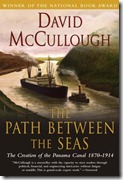 From then on the books that earned permanent positions on my shelf were those that expanded my understanding of this world. Some were quite specific, like David McCaulay’s The Path Between the Seas: The Creation of the Panama Canal, 1870-1914, which carried me through the Panama Canal and northward through Central America, or William Beebe’s 1926 book The Arcturus Adventure recounting his New York Zoological Society expedition by ship to the Galapagos and Cocos Islands which partnered our own trip there.
From then on the books that earned permanent positions on my shelf were those that expanded my understanding of this world. Some were quite specific, like David McCaulay’s The Path Between the Seas: The Creation of the Panama Canal, 1870-1914, which carried me through the Panama Canal and northward through Central America, or William Beebe’s 1926 book The Arcturus Adventure recounting his New York Zoological Society expedition by ship to the Galapagos and Cocos Islands which partnered our own trip there.
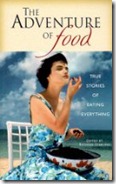 In Mexico, someone gave me a copy of Travelers’ Tales Mexico, a collection of travel writing about the country. This introduced me to the genre of travel writing and the whole list of Traveler’s Tales titles, numbers of which I ordered and devoured including collections of travel writing about particular places like Australia and Thailand, about food (The Adventure of Food was an early favorite), and several women’s travel collections. These books began to influence the way I wrote my own Blog.
In Mexico, someone gave me a copy of Travelers’ Tales Mexico, a collection of travel writing about the country. This introduced me to the genre of travel writing and the whole list of Traveler’s Tales titles, numbers of which I ordered and devoured including collections of travel writing about particular places like Australia and Thailand, about food (The Adventure of Food was an early favorite), and several women’s travel collections. These books began to influence the way I wrote my own Blog.
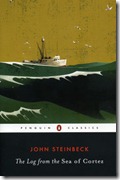 The travel collections led me onward to books by the contributors like Bill Bryson, Tim Cahill, and Paul Theroux as well as authors whose work, fiction or non-fiction, is deeply immersed in place. My interests ranged from places I was actually visiting (a reread of Steinbeck’s The Log from the Sea of Cortez while in Baja California seemed appropriate), to places I was far from, like Isabel Allende’s The House of the Spirits (Chile), and Jorge Varga Llosa’s The Feast of the Goat (Dominican Republic.) A shopping bag of English-language books from Southeast Asia acquired in La Paz sent my mind roving for months through Myanmar, Indonesia, India and Afghanistan, places I’d never otherwise reach. I particularly enjoyed Simon Winchester’s non-fiction Krakatoa: The Day the World Exploded, even though it, too, was unsettling and foreshadowed the Indonesian tsunami.
The travel collections led me onward to books by the contributors like Bill Bryson, Tim Cahill, and Paul Theroux as well as authors whose work, fiction or non-fiction, is deeply immersed in place. My interests ranged from places I was actually visiting (a reread of Steinbeck’s The Log from the Sea of Cortez while in Baja California seemed appropriate), to places I was far from, like Isabel Allende’s The House of the Spirits (Chile), and Jorge Varga Llosa’s The Feast of the Goat (Dominican Republic.) A shopping bag of English-language books from Southeast Asia acquired in La Paz sent my mind roving for months through Myanmar, Indonesia, India and Afghanistan, places I’d never otherwise reach. I particularly enjoyed Simon Winchester’s non-fiction Krakatoa: The Day the World Exploded, even though it, too, was unsettling and foreshadowed the Indonesian tsunami.
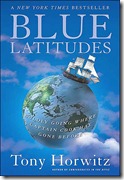 Cruising in the Pacific, my reading shifted nearer to hand:
Cruising in the Pacific, my reading shifted nearer to hand:
- Tony Horowitz’s Blue Latitudes (following Captain Cook’s voyages);
- Gavin Young’s Slow Boats Home (in which he travels by tramp steamer east across the Pacific from Asia);
- Thor Heyerdah’s Fatu-Hiva ,
- Melville’s Typee (Marquesas),
- Maugham’s The Moon and Sixpense (Tahiti);
- Jennifer Vanderbe’s Easter Island
- and Michener’s Tales of the South Pacific.
In Tonga I found William Mariner’s An Account of the Natives of the Tonga Islands; In the South Pacific Ocean, his true account as a boy of surviving a massacre of his ship to be “adopted” by the local cannibals, and in Fiji I plunged into R.A Derrick’s eye-opening A history of Fiji plus Paul Theroux’s somewhat jaundiced The Happy Isles of Oceania: Paddling the Pacific in which he and his kayak work their way east from Australia.
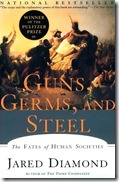 Last year one book really jumped out from the others as reading pertinent to cruising: Jared Diamond’s Guns, Germs, and Steel: The Fates of Human Societies. I was reading it as we sailed through tribal Vanuatu. It presents a persuasive analysis of the differences in development by the many different cultures of the world all based on the logical platform of what their bit of earth historically offered them in fundamental resources like domesticable animals or grains. Guns, Germs and Steel was definitely one of those “ah-hah!” books for me.
Last year one book really jumped out from the others as reading pertinent to cruising: Jared Diamond’s Guns, Germs, and Steel: The Fates of Human Societies. I was reading it as we sailed through tribal Vanuatu. It presents a persuasive analysis of the differences in development by the many different cultures of the world all based on the logical platform of what their bit of earth historically offered them in fundamental resources like domesticable animals or grains. Guns, Germs and Steel was definitely one of those “ah-hah!” books for me.
Of course, these are just some of the books that made up the mental voyage that partnered my physical voyage, both of which, of course, are uniquely mine. Few of the books had any direct impact our on our sailing, but neither did the murder mysteries or the romances! Not one of them is a contemporary sailing book, the kind people typically read to prepare for cruising. Truthfully, I didn’t discover such books until I starting coming back to the States and going to boat shows…about the time I became involved with Women and Cruising and started this column!
When I did, I had to start a whole new shelf! (To be continued next month.)
(Note: On www.womenandcruising.com we are launching a new page about the Cruising Woman’s Bookshelf. Send us your booklist recommendations.)
This article was published in the January 2010 issue of Latitudes and Attitudes.
Related articles (on this website)
- Bookshelf – Part Two: Cruising Sagas (Admiral’s Angle #43)
- A cruising bookworm loves her new Ebook reader (Women and Cruising blog)
- Taking Passions Cruising (Admiral’s Angle column #41)
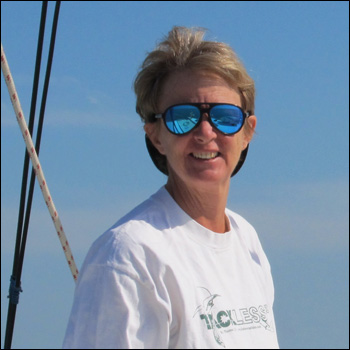
I really did appreciate the Women’s Bookself…I wanted to pack up some books with a bit more “meat on the bones” so to speak and this gave me some good ideas. Thank you so much….also I have enjoyed reading all of your columns in Lats and Atts. Keep up the good work.
-Candy
M/V The Bootlegger